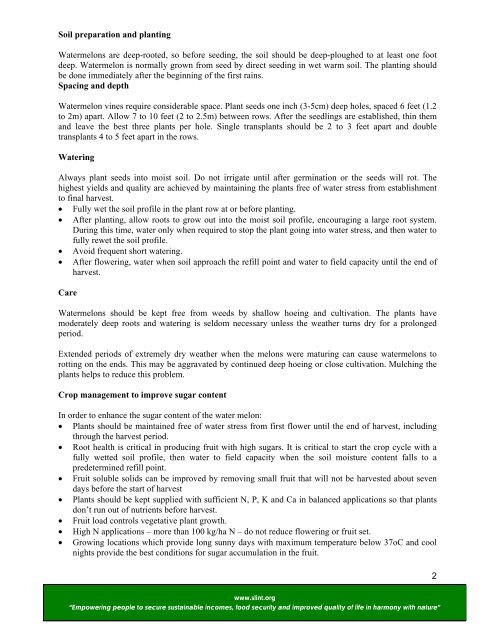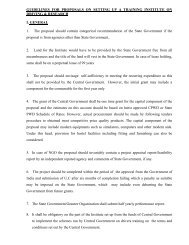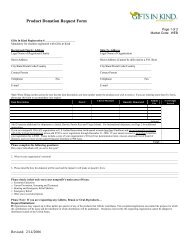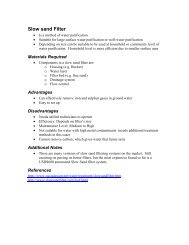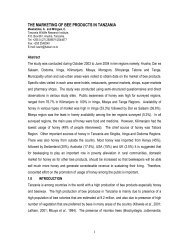FACT SHEET 1-Water Melon growing.pdf - Nabuur
FACT SHEET 1-Water Melon growing.pdf - Nabuur
FACT SHEET 1-Water Melon growing.pdf - Nabuur
You also want an ePaper? Increase the reach of your titles
YUMPU automatically turns print PDFs into web optimized ePapers that Google loves.
Soil preparation and planting<br />
<strong>Water</strong>melons are deep-rooted, so before seeding, the soil should be deep-ploughed to at least one foot<br />
deep. <strong>Water</strong>melon is normally grown from seed by direct seeding in wet warm soil. The planting should<br />
be done immediately after the beginning of the first rains.<br />
Spacing and depth<br />
<strong>Water</strong>melon vines require considerable space. Plant seeds one inch (3-5cm) deep holes, spaced 6 feet (1.2<br />
to 2m) apart. Allow 7 to 10 feet (2 to 2.5m) between rows. After the seedlings are established, thin them<br />
and leave the best three plants per hole. Single transplants should be 2 to 3 feet apart and double<br />
transplants 4 to 5 feet apart in the rows.<br />
<strong>Water</strong>ing<br />
Always plant seeds into moist soil. Do not irrigate until after germination or the seeds will rot. The<br />
highest yields and quality are achieved by maintaining the plants free of water stress from establishment<br />
to final harvest.<br />
• Fully wet the soil profile in the plant row at or before planting.<br />
• After planting, allow roots to grow out into the moist soil profile, encouraging a large root system.<br />
During this time, water only when required to stop the plant going into water stress, and then water to<br />
fully rewet the soil profile.<br />
• Avoid frequent short watering.<br />
• After flowering, water when soil approach the refill point and water to field capacity until the end of<br />
harvest.<br />
Care<br />
<strong>Water</strong>melons should be kept free from weeds by shallow hoeing and cultivation. The plants have<br />
moderately deep roots and watering is seldom necessary unless the weather turns dry for a prolonged<br />
period.<br />
Extended periods of extremely dry weather when the melons were maturing can cause watermelons to<br />
rotting on the ends. This may be aggravated by continued deep hoeing or close cultivation. Mulching the<br />
plants helps to reduce this problem.<br />
Crop management to improve sugar content<br />
In order to enhance the sugar content of the water melon:<br />
• Plants should be maintained free of water stress from first flower until the end of harvest, including<br />
through the harvest period.<br />
• Root health is critical in producing fruit with high sugars. It is critical to start the crop cycle with a<br />
fully wetted soil profile, then water to field capacity when the soil moisture content falls to a<br />
predetermined refill point.<br />
• Fruit soluble solids can be improved by removing small fruit that will not be harvested about seven<br />
days before the start of harvest<br />
• Plants should be kept supplied with sufficient N, P, K and Ca in balanced applications so that plants<br />
don’t run out of nutrients before harvest.<br />
• Fruit load controls vegetative plant growth.<br />
• High N applications – more than 100 kg/ha N – do not reduce flowering or fruit set.<br />
• Growing locations which provide long sunny days with maximum temperature below 37oC and cool<br />
nights provide the best conditions for sugar accumulation in the fruit.<br />
2<br />
www.slint.org<br />
“Empowering people to secure sustainable incomes, food security and improved quality of life in harmony with nature”


